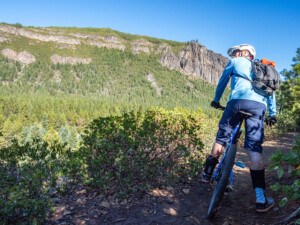We’ve done city biking for years using two wheeled chariots that we picked up for a few hundred. It wasn’t too hard to choose one. Now mountain biking was a different story. One of the biggest hurdles for us to be like Doc from Back To The Future II and get off the paved paths was the vast amount of options to choose from. We wanted to try the sport, but I got stuck in analysis paralysis. Do I need that eight-thousand-dollar Santa Cruz 5010 Carbon beauty? What is a trail bike? A Cross-country bike? Enduro? I was terrified on choosing the wrong one. Exhausted and overwhelmed, I turned to our local shops in Tahoe yet again. Here’s what we found about all the types of mountain bikes and what to look for.
We’re Passionate Pedalers

We don’t claim to be experts. Just two people that are passionate about the sport. We’ve been given the rare opportunity to have such a great community of willing folks to share their knowledge. Kent at Wattabike is a mechanical genius. Ken and Lani at Shoreline of Tahoe push people outside by setting up rides including even some women only outings. Gary at Sierra Cycle Works is one of the OGs that helped pioneer the trails including Toad’s on “Klunkerz.” The list of great individuals could go on and on. Instead of hoarding all the information, we want to share the down & dirty on mountain biking and help everyone get into this amazing outdoor activity.
How To Find Right Bike For The Job
It’s kind of crazy how quickly the price of a kitted-up ride can ratchet. From a few hundred up to thousands of dollars. You might get sticker shock. We did. We thought all mountain biking was the same. Why do you need that high-end bike with all the bells and whistles? I mean, you’re going off-road. What more do you need to know about types of mountain bikes?

Well, the fact is terrain and the type of obstacles you will be confronting need to be taken into account. We learned this the hard way when we headed up to Grand Targhee and tried lift access mountain biking for the first time. Jaime tried using her normal full suspension bike, and it was like bringing a pocketknife to a full-fledged war. The brake pads burned up. The suspension needed to be refreshed. Pretty much a full tune just from a half a day of riding downhill. Even so, you don’t NEED a hardcore downhill steed for your daily driver. Rather, when you first start mountain biking, don’t go for the most high-end luxurious model. Pick something that gives you room to improve or upgrade over time but at the same time affordable.
Style Of Riding
Diving into that concept some more, you really need to think about HOW you’re going to use the bike. Do you live in the mountains or in the great plains? About riding park or using a shuttle to get you to the top. Tacky smooth dirt paths or dusty rock gardens. A first-timer or a grizzled veteran. Maybe it’s all of the above. Take these things into account when picking the bike.
Look To Racing Disciplines

One way to do this by looking at the racing disciplines that exist for pedaling off-road. This is where the technology is pushing the limits of what’s possible. It’s also an easy way to figure out what are the types of mountain bikes and which one you want to pick up:
Cross-Country
This is where most beginners will and should gravitate to. You’re getting your first taste of riding off-road. This consists of wide-open fire roads that are typically covered in gravel to narrow singletrack with only a few minor obstacles. Using a full suspension bike for only this type of terrain is overkill especially when you start inching towards rides past thirty or forty miles. At the most, you want suspension on the front wheel. The focus is about maximizing pedal performance.
Downhill
On the other side of the spectrum, you’ll find downhill. Think of skiing or snowboarding. Bikes used for this discipline are focused on one thing – going downhill. Trails are filled with brutal features. Anything from cliffs, rock gardens, and everything in between. You’re going fast and the bike needs to take the abuse and laugh it off. Full-face helmets, body armor, and chest protectors are the normal uniform. Instead of pedaling up, you’re typically taking a lift or shuttle service to get you to the top for some gravity fed fun.
Freeride
While downhill focuses on getting down at the fastest time possible, Freeride Mountain biking is about doing it with style and finesse. Big airs and tricks matter. These are competitions like the Red Bull Rampage.
Enduro / All-Trail
Sometimes you need to have your cake and eat it too – that’s where Enduro comes in. A hybrid of downhill and cross-country. Out of any racing discipline, this is where the biggest leaps in technology have come to combat anything Mother Nature throws at you. Ideas like seat droppers and on-the-fly suspension adjustments have come because of races like the legendary Downieville Classic.
Types Of Mountain Bikes
No matter which brand you go with, the types of mountain bikes to pick from fit into two specific categories of construction – hardtail and full suspension.
Hardtail Mountain Bikes
As the name would suggest, a “hardtail” means the back of the frame is rigid. That means it doesn’t feature a rear shock. In most cases, hardtail mountain bikes still come with a front shock (like the Ibis DV9). What you lose in versatility and capability in rough terrain, you gain in weight-loss. On average, hardtails are about two pounds lighter than their equivalent full suspension version of the same brand due to the components. As you would expect, this translates to more efficient pedaling effort and thus easier for climbs.
Full Suspension Mountain Bikes
Like yin and yang, the full suspension is the yang to hardtails. This is where it in fact does have rear suspension as well as on the front. And just like a truck in the Baja 500 with independent suspension, it helps you stay in more control in the most challenging of trails. I can tell you personally that this control quickly translates to an instant confidence boost. What suspension giveth in control it taketh away in weight. Two pounds may not sound like much, but it adds up quickly mile after mile of climbing. With all that being said, technology keeps improving these components and allowing for you to get even lighter. That of course is one of the ways the price tag ratchets up.
How Shops & Websites Categorize
Some bike companies make it easier for you and organize based on racing discipline. Others just showcase their offerings and go “have-atcha.” Finally, shops and online websites like Backcountry.com or REI categorize based on Cross-country, Trail, maybe a few Enduro, and finally downhill. Think of it not as hard differentiators but a scale from left to right on the different types of mountain bikes.
Cross Country Mountain Bikes (XC)
Yeti SB115 | Santa Cruz Blur | Ibis Exie
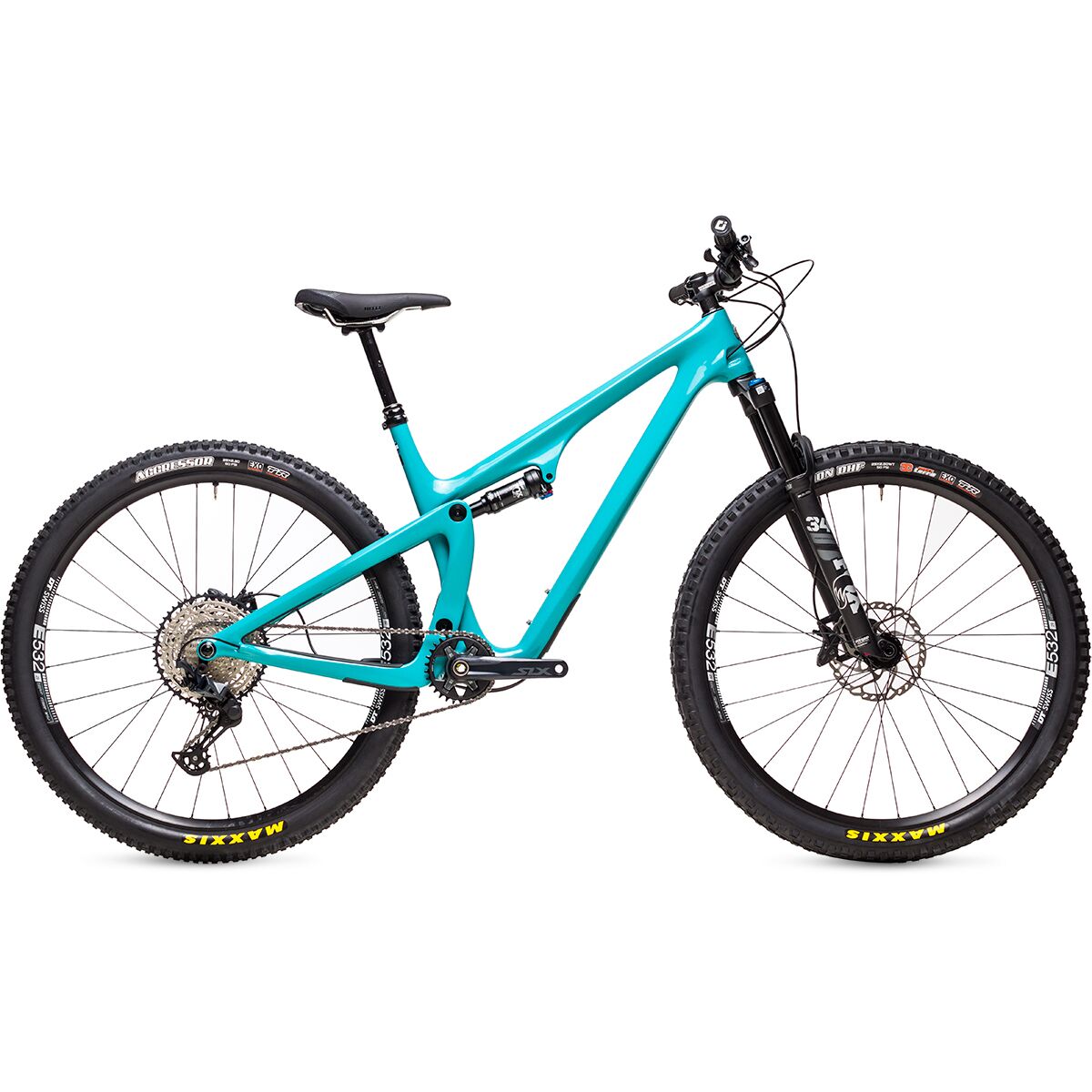
These types of mountain bikes are designed for smoother off-road adventures. Designed to minimize pedal effort and agility. As such, you’ll see most of the hardtail arsenal in this category. If there is a front fork suspension, they’ll normally have an air spring (more on that below in the components section) with travel between 110 and 120 mm. And for the rear, expect a range between 80mm — 120mm and lockout (i.e. make it stiffer) to help make climbing easier.
You’ll find a longer stem to put the ride in a posture to reduce the pedaling effort. You’ll also find handlebars are normally a bit narrower to allow for quick navigation on tight turns. Cross country bikes normally contain a smaller rotor to reduce the weight as well as the fact that they get a bit twitchy on downhill. A big rotor would only make things even worse in a downhill scenario. Do you remember when we talked about Jaime burning her brakes on the downhill? It’s because her go-to model is in between a cross county and trail variety. Long downhills and big technical terrain are a recipe for disaster if you aren’t picking your way through it.
Trail Bikes
Yeti SB130 | Santa Cruz 5010 | Ibis Ripley

As you would suspect, these are one step up from the Cross-county variety. Full suspension is now the norm. Although you may find a few that are hardtails with longer forks. The handlebars are going to be a bit wider allowing for more leverage when you have to navigate beastly obstacles. The suspension travel is ratcheting up to 120mm to 160mm on the front.
These are built in a way that you can pretty much point it and “give ‘er” in most hard stuff. They still have a lockout on the rear suspension to help you climb and spinning along in meadows. Brake rotors are now getting bigger to help provide a bit more “whoa” when you need it. Remember there isn’t a hard line between these categories. You will find versions that lean towards a XC with smaller geometry and easier pedaling and others that go towards an Enduro / Downhill horse.
Enduro
Yeti SB150 | Santa Cruz Nomad | Ibis Ripmo
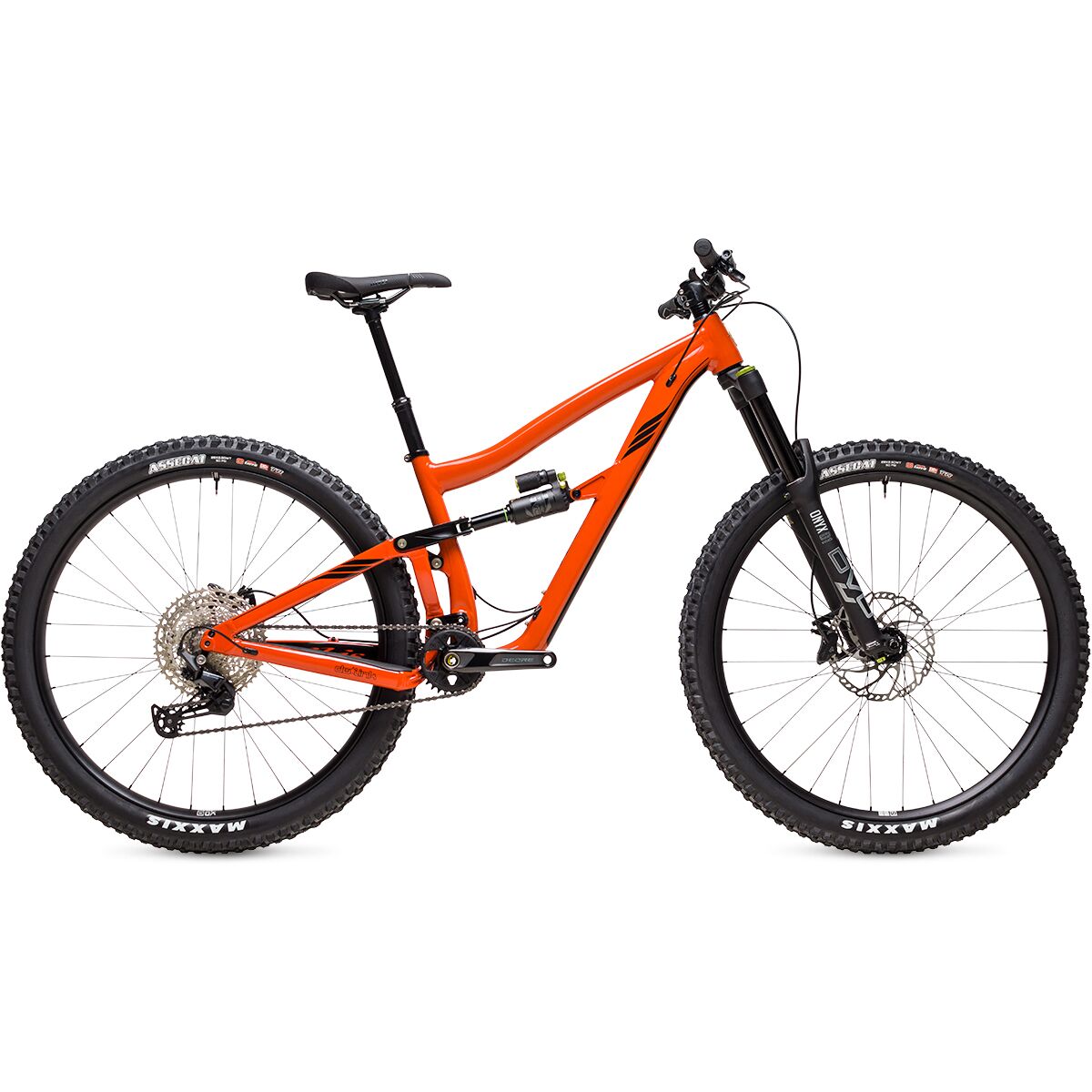
Pedaling up the list (pun intended) you’ll find the Enduro models. The goal of theis monster is a beefy one. You want something that can tackle the rowdiest downhill as well as possible. And at the same time, they can’t sacrifice on pedaling efficiency. A true jack of all trades. You’ll find the suspension yet again getting burlier. Now, you’ll find travel between 150mm to a whopping 180mm. They’re designed to take a licking and keep on ticking. And therefore, their wheelbase is longer than a trail bike. Their components are beefier (think like a Baja truck) – larger brake rotors, wider rims, forks with larger stanchions, and a host of other items. As you would expect, this comes with a charge. For first timers and even intermediate riders, this is overkill. You’ll make the uphill harder when you don’t have to.
Downhill
Yeti SB165 | Santa Cruz V10
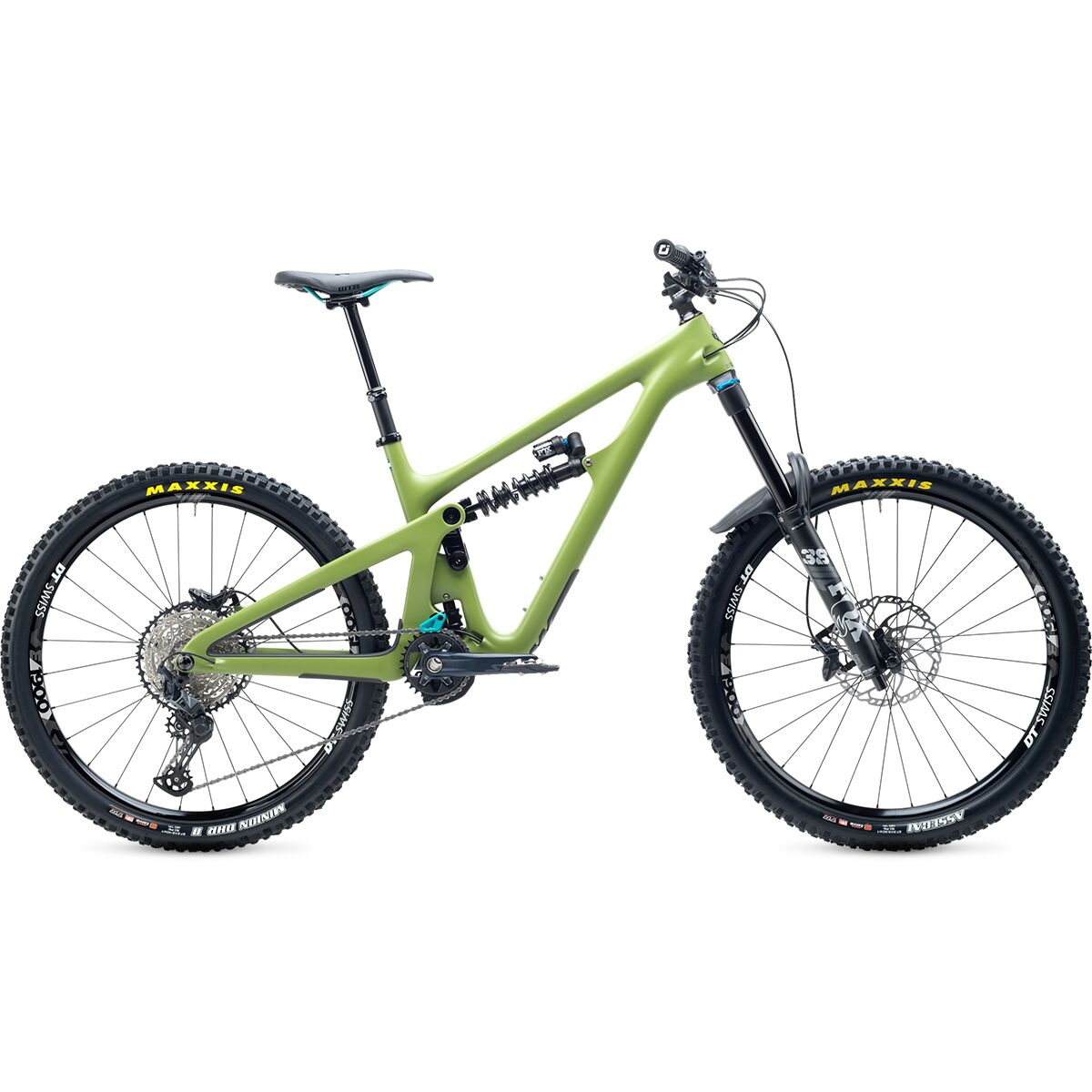
As the boys from Sandlot yell – these are the sultans of swat. The titans of terror. The colossae of clout. The kings of crash! They’re built for one thing and they do it well. Gravity fed adrenaline pumping downhill. You’ll find two wheeled monsters with coil springs and suspension travel upwards of 200mm. They’re even bigger and burlier than an Enduro bike. Since they’re going downhill, the cockpit has been set the furthest back out of all the models we’ve talked about. This is the mountain biking version of a big wave surfboard you’d find at Mavericks. Unless you’ll be doing burly lift or shuttle access lines only, we’d recommend renting these instead.
Fat Bikes
If Sir Mix-a-lot was a cyclist, he’d rap “I like fat tires and I cannot lie.” As you’d expect, fat bikes are those designed to have a wide tire. Instead of using full suspension to ride over rough terrain, their fat tires are their “own suspension.” Depending on who you talk to, some may not even call this one of the types of mountain bikes out there. Think of them as the bridge between a hardcore mountain bike and a regular one. They work very well on trails that are covered in deep snow, sand, or a mix of all of the above. They are heavier which translates to more effort pedaling. Don’t think of them as a budget version either. They can run you a $1,000 or more.
What It’s Made Of
Speaking of how heavy a bike is, the structural foundation is the bike frame and also the heaviest component on it. Most frames today are made of either steel, aluminum, titanium, or carbon fiber. Depending on your budget and what you’ll be using it for will determine which material is used in the manufacture of it.
Steel
The first steeds in the 70s were made of steel. This included the first mass produced one — the Specialized Stumpjumper (which has evolved into other materials). Specifically using Chromoly steel, it was strong, durable, and could take a beating. The downside as you would expect is how heavy beasts are when they use steel. It’s still the most budget friendly and easy to manufacture. That’s why you’ll find department store mountain bikes typically made of it. You will find a handful of hardtail varieties focused on putting the $$$$ into high-end components instead like the Salsa Rangefinder Advent that use steel for their frame.
Aluminum
By the mid 80’s, companies started to realize there had to be a way to build a lighter mountain bike. In came Aluminum. Just like any new innovation, the first few years this variety developed a reputation for a harsh ride. That’s no longer the case, and to this day, it’s still the 2nd lightest material on the market. Most manufacturers such as Santa Cruz and Ibis (marked with an AF) offer models made of it because it can be lightweight and still offered for several thousand less than their carbon versions. In addition, they can take a beating and keep on ticking without issue. A great alternative for beginners and those who want to throw the bike in the back of a truck and not worry if it gets dinged up a little.
Carbon Fiber
A material unlike any others on the list. Instead of being made with a metal, it’s a material. Yup, you read that right. It’s a combination of epoxy and fibers. In simplest terms, it’s woven tightly into a grid and layered around a bladder mold, pressurized, and then heat-treated. The result is the lightest variety of frames on the market. Even in my rudimentary explanation of the carbon fiber manufacturing process, you can tell it’s complex. And so, these types of mountain bikes are expensive. Similar to the evolution of aluminum, it’s had its hiccups but most of the carbon fiber issues have been dispelled. Expect to pay a pretty penny if you want one. For most beginners, this material cost isn’t worth it. Some believe in it so much that all they do is offer bikes made of it such as the company Niner. Even with many of the issues solved for carbon fiber, pick a company that provides a lifetime warranty on their frames.
Titanium
Back in the 90’s when manufacturers were exploring lightweight and strong options, titanium came in the market. MUCH lighter than steel. Stronger than aluminum, its hulky tensile strength allows it to be made thinner. Providing more natural dampening than carbon fiber, it’s a good choice for those that want a bike frame that can last decades. Unfortunately, since titanium is a very rigid metal, it’s difficult to manufacture and can be as costly as a carbon fiber frame. And so, it’s a very niche market for specific consumers.
Components
 You think cars and trucks have a lot of bells & whistles? Mountain bikes are up there especially that they don’t even have a motor (well there are E-Bikes but that’s a whole different conversation). This is NOT even close to the full list of components but an introduction of why one bike may cost more than another. You can also pretty much add or upgrade almost any of these components (except for rim size).
You think cars and trucks have a lot of bells & whistles? Mountain bikes are up there especially that they don’t even have a motor (well there are E-Bikes but that’s a whole different conversation). This is NOT even close to the full list of components but an introduction of why one bike may cost more than another. You can also pretty much add or upgrade almost any of these components (except for rim size).
Suspension
 Out of any part of the bike, this is one that we still don’t fully get. One thing we can tell you is that once you do finally buy a model, bring it into a shop so they can get the shocks set based on your weight and skill level. Like every part on the bike, the nicer it is, the more expensive it will be. This includes:
Out of any part of the bike, this is one that we still don’t fully get. One thing we can tell you is that once you do finally buy a model, bring it into a shop so they can get the shocks set based on your weight and skill level. Like every part on the bike, the nicer it is, the more expensive it will be. This includes:
What they’re made of
Similar to a bike frame, what the stanchion is made of will increase the price and includes materials like steel and aluminum.
Customization
Besides the initial setup, you’ll see words like “adjustable travel.” This allows you as the rider to change how soft or hard the suspension is when riding the bike. Another common feature you’ll find is a chance to lockout. Think of it as a way to make the full suspension a hardtail for the climb up (not perfect but better than nothing).
Travel
There are a LOT of numbers on the specs for a suspension, but the one to pay most attention to is the travel. This is how much the suspension will move before it maxes out. Ranging from 100mm to 200mm+, the higher this number the more it leans towards helping with downhill. Depending on the website, you may also see a number next to the suspension that reads 200 x 57mm. This is the overall length of the shock followed by how much of it can be compressed (i.e. stroke). For this example, the shock from eyelet to eyelet is 200mm, and it has a stroke of 57mm.
Brake System
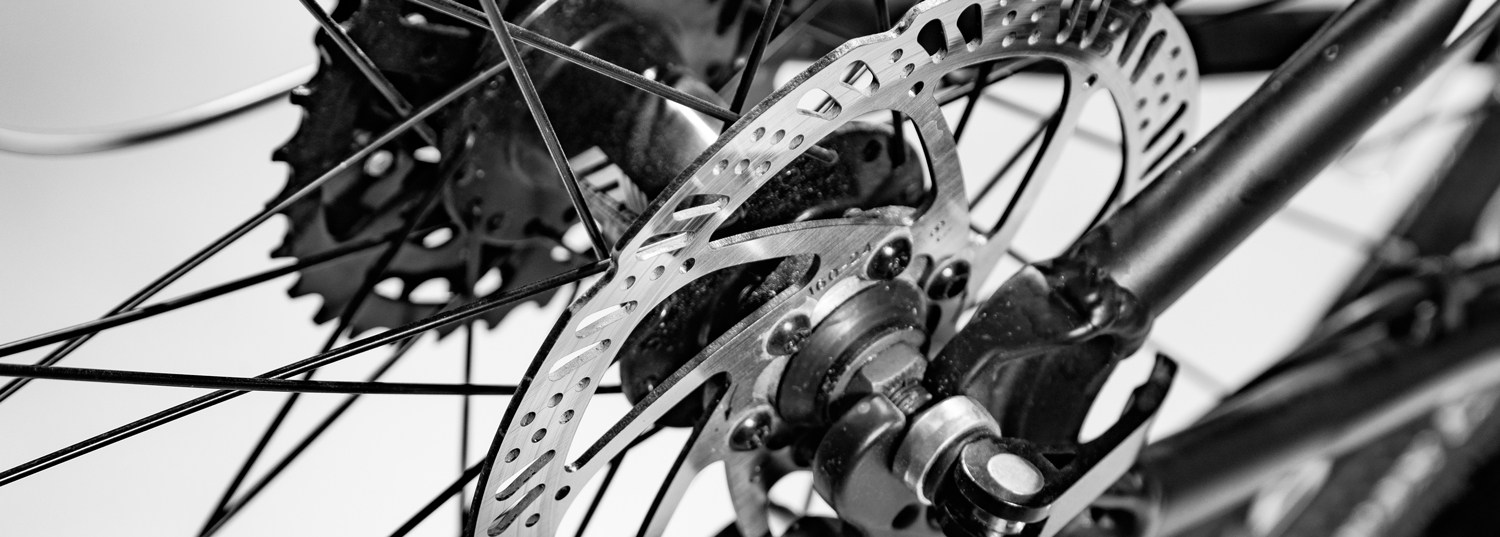 Within the universe of bikes as a whole, you’ll find three types of brakes: disc, rim, and V-brakes. The only ones that should be in the running are disc brakes. Think of them as the bike version of the ones on your car (or truck). The size of the rotors varies from around 140mm to a hefty 200+. Similar to the suspension, the bigger the rotors the heavier the components which translates to more work pedaling. Another option is to have a bigger brake rotor at the back than the front allowing you to have the best of both worlds.
Within the universe of bikes as a whole, you’ll find three types of brakes: disc, rim, and V-brakes. The only ones that should be in the running are disc brakes. Think of them as the bike version of the ones on your car (or truck). The size of the rotors varies from around 140mm to a hefty 200+. Similar to the suspension, the bigger the rotors the heavier the components which translates to more work pedaling. Another option is to have a bigger brake rotor at the back than the front allowing you to have the best of both worlds.
Gears
From personal experience, we can tell you that front derailleurs suck on mountain bikes. Jaime pushes her mountain bike hard, and out of any component on the bike, the #1 reason we ended up in the shop getting a tune was because of it. And so, we finally took the leap and got rid of it on our bikes. We couldn’t be happier by joining the one-by drivetrain community (meaning one cassette on the front). Due to how old our bikes are, we could only get a 10-speed on the back. Most modern bikes have a wider frame allowing you to have an eleven or even 12-speed cassette ranging from 10 teeth – 50 teeth. These cover pretty much the same spectrum as a 24 speed bike but MUCH lighter and with less things to go wrong.
Tires

When modern mountain bikes started, the standard was a 26-inch rim. Nowadays nearly all models come with either 27.5(650b) or 29-inch(niners) rims. Whatever rim size is on the bike, you’re pretty much stuck with. Even so, one of the easiest things you can do to upgrade your ride once you pick one is to switch the tires that fit the terrain you’ll be riding. It’s a complex topic and so our article Wheels On the Bike Go Round & Round – The Best Mountain Bike Tires goes into everything you need to know about tires and the best brands out there.
Dropper Post
Similar to sliced bread, you don’t HAVE to have it, but when you do, you REALLY appreciate it. When mountain biking, you want to lower the seat out of the way on downhill descents. Until this invention, most riders had to get off and manually lower it. And then raise it again during climbs to maximize pedaling efficiency. A lot of riders used to settle for a mid-level seat height. Not anymore. As the name dictates, a dropper post allows you to change the height on-the-fly. Most seat droppers have a switch that’s on the handlebar. This is another piece of technology you can add afterwards but helpful if it already comes with it.
Start Simple & Build
My father always used to say, “get something affordable first so that you’re ok breaking it while you learn. As you get better then upgrade.” And that’s exactly what we did. We found a bike that fit our needs to make it easy to learn but wouldn’t break our bank account. Along the way, we’ve upgraded components. If you want to follow our path, look for:
- Aluminum frame (more durable & cheaper)
- Full suspension (leaning towards a cross-country variety)
- 29-inch rims (27-inch is ok but then you can’t upgrade to a 29-inch in the future)
- Disc brakes (leaning towards a cross-country model)
Anything else like a seat dropper post, 1×12 gears, beefy suspension, or monster brake rotors are just the cherry on top.
We hope this helps demystify what are the different types of mountain bikes out there and helps you find the right one for your needs. Happy pedaling!







